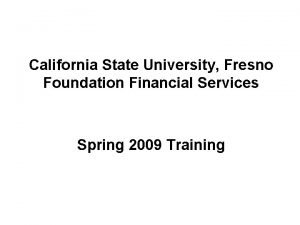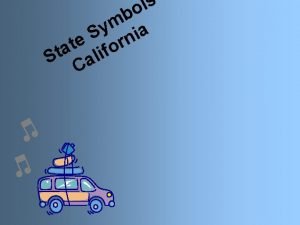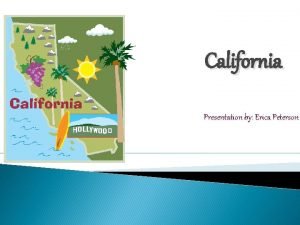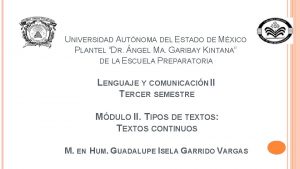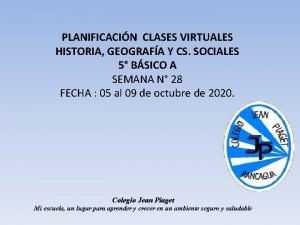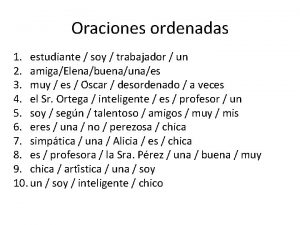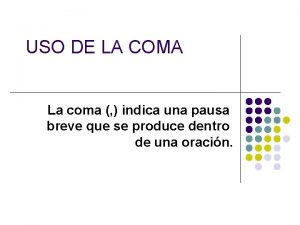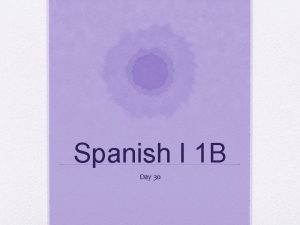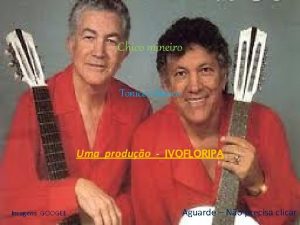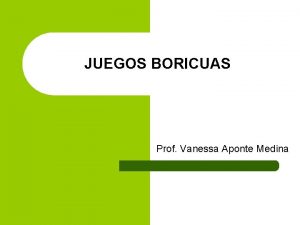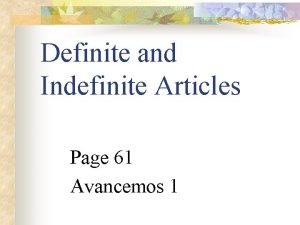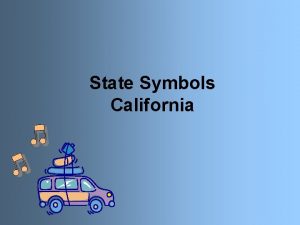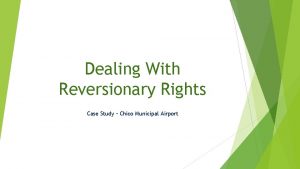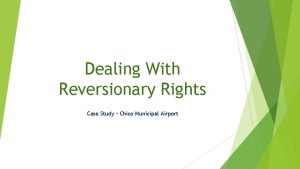Case 1 M H Chico State U California





























- Slides: 29


Case 1 - M. H. (Chico State U. , California) n n 18 M presents after 3 grand-mal seizures after collapsing during fraternity hazing ritual Pledges were forced to do push-ups/exercises for hours in raw sewage that had leaked into basement of fraternity Kept drinking from 5 gallon jug of water which was continuously refilled Vomitted and urinated on themselves

Case 1 n Initial vitals: n n n 120/60 70 20 98% RA T=37. 5 Clinically euvolemic Confused

Case 1 n n Initial labs Na = 110, urine Na <10, serum osmol = 270 How would you treat?

Hyponatremia Matthew Harrington Sultana Qureshi, R 2 Lab Rounds Feb 8, 2007

Hypo. Na Basics n n n Hypo. Na is a symptom of disease Na <135 m. Eq/L Most common lyte abn in hospital pts Incidence 1%, increases with age Acute, symptomatic cases, mortality up to 18%

Quick Physiology Review n 3 fluid compartments n n (2/3) ICF & (1/3)ECF (Interstitial. F + IVF) Na concentration governs movement of water across these spaces Body tightly maintains serum osmolality within 1 -2% of 275 -295 mosmol/kg n Na balance = Renin-angiotensin n Water balance = ADH

Quick Physiology Review n n Hypotension or low ECF renin release from JGA angiotensin II aldosterone production Na reabsorption and K excretion Incr serum osmolality, Decr. BP or volume ADH release from post. Pituitary n More sens to hypovolemia than low osmol.

Clinical Features n Absolute Na level not as important as RATE OF DECLINE

Symptoms Serum Na+ (m. Eq/L) Symptoms 135 - 130 Decreased taste 130 - 125 Thirst Anorexia, N + V Muscle cramps 125 - 120 Weakness Lethargy Restlessness Confusion Delirium Coma Seizures < 120 Thanks to Moritz!

Approach n n Classify Osmolality and Volume status Osmolality n n n Hyperosmolar – excess solutes (ie glucose) draw water into ECF diluting Na Iso-osmolar – psuedohyponatremia Hypo-osmolar (MOST COMMON) – excess water in relation to Na stores (may be incr, decr or n) – categorized by volume status

Hypo-osmolar Hypo. Na n Hypervolemic n n Euvolemic n n CHF, ARF, CRF, cirrhosis/ascites, pregnancy SIADH, adrenal insuff, hypothyroid, psychogenic polydipsia, sports Hypovolemic n Diuretics, diarrhea, sweating, third-spacing, saltwasting nephropathy

Causes of SIADH n CNS disease n n n Brain tumor infarction injury abscess Meningitis/ Encephalitis n Drugs n n Pulmonary disease n n Pneumonia Tuberculosis Lung abscess Pulmonary aspergillosis n n n Exogenous vasopressin (enuresis) Diuretics Chlorpropamide Vincristine Thioridazine Cyclophosphamide


Most common is hypo-osmolar hyponatremia

Case 2 n n 75 F – weak and dizzy x 1 week, falls at home presenting with hip # PMHx – Hyperlipidemia, HTN, chronic diarrhea NYD Meds: HCTZ, lipitor Vitals: 85, 110/70, 14, 95% RA

Case 2 n n n Labs: Na- 112, K-4. 5, Cl- 82, CO 2 -12 Serum osmol – 240 Urine osmol – 300 Urine Na - <10 Cause of Hypo. Na? How would you treat?


Management n n Guided by severity of symptoms and acuity Chronic n n Gradual correction <0. 5 m. Eq/L/hr Acute/Symptomatic n Tolerate faster correction up to 1 -2 m. Eq/l/hr


Management n CNS symptoms/seizures n n Correct with hypertonic saline (3%) until resolved usually need to increase Na by 4 -6 m. Eq/L only Then correct 8 -10 m. Eq/L/day Formula n (Desired [Na+] – measured [Na+] ) x 0. 6 Wt(kg) = m. Eq Na+ req’d n Eg (117 -112) X 0. 6(70) = 210 m. Eq


Case 2 (continued) n n n It’s July 1 st and the Ortho R 1 decides to fluid resuscitate her with NS 2 L bolus, then runs it at 200 cc/hr Pt admitted to Ortho Next morning, Na corrected to 136 Later that evening, pt develops confusion, dysarthria, unable to move her arms and legs What’s happening? Call stroke team?

Central Pontine Myelinolysis (CPM) n Overaggressive correction of the serum sodium level (usually >12 m. Eq/L/day) n Destruction of myelin in the pons (due to rapid changes in cell volume? ) n Pts may develop confusion, cranial nerve palsies, spastic quadriplegia, or coma n More likely to occur in patients with chronic hyponatremia n Most cases reported in alcoholic, malnourished, and elderly patients n Can develop 1 -3 days after rapid Na correction n Diagnosed by MRI n Supportive Management



Treatment (mild-mod symptoms) n Hypovolemic hyponatremia n n Correct with NS (0. 9%) Euvolemic hyponatremia: n n n Restrict free water intake Treat underlying cause No NS in SIADH: n n n Worsens due to excessive water retention Lithium and demeclocycline Hypervolemic hyponatremia: n n Restrict free water intake +/- diuretics (may increase Na loss)

Case 3 (Jan 12, 2007 – Sacremento, CA) n 28 F enters radio station competition “Hold your Wee for a Wii” n n n Contestant who could drink the most water without urinating won Possibly drank up to 2 gallons Nurse called into radio station during competition stating danger Last heard from while driving home with severe headache Found dead next morning

Questions?
 Delgada canadiense enamorado lista seguro enojada
Delgada canadiense enamorado lista seguro enojada Best worst and average case
Best worst and average case Griffin v. california
Griffin v. california Ca state plane zones
Ca state plane zones California state university long beach nursing
California state university long beach nursing California state university fresno foundation
California state university fresno foundation California state motto
California state motto California state animal
California state animal State of california dgs
State of california dgs California state standards english
California state standards english California state plan
California state plan California state seal of civic engagement
California state seal of civic engagement California
California California state fossil
California state fossil California state standards physical education
California state standards physical education Prosopografia
Prosopografia El relieve chileno
El relieve chileno Adelia prado e chico buarque estabelecem intertextualidade
Adelia prado e chico buarque estabelecem intertextualidade Perfil topografico zona sur
Perfil topografico zona sur Oraciones de fortaleza
Oraciones de fortaleza Macroforma norte grande
Macroforma norte grande Arnulfo chico robles
Arnulfo chico robles Características de la zona sur de chile
Características de la zona sur de chile Sufijos aumentativos ejemplos
Sufijos aumentativos ejemplos Dora chico
Dora chico Es un chico muy reservado estudioso y de buena familia
Es un chico muy reservado estudioso y de buena familia Es un tito perezoso chico
Es un tito perezoso chico Tonico & tinoco chico mineiro
Tonico & tinoco chico mineiro Tirabete
Tirabete Chico definite article
Chico definite article





